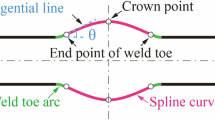Abstract
Fatigue test results of 16 Mn steel butt welds without crack-like defect under both constant and variable amplitude loads are reported and new procedures are used to predict fatigue crack initiation (FCI) life, fatigue crack propagation (FCP) life and total life of the butt welds. The results indicate that the FCI life and FCP life should be calculated separately and the total life is the sum of the FCI life and FCP life. For the butt welds investigated, stress cycles to initiate a crack of engineering size may occupy more than 70 percent of the total life of the butt welds and it is more suitable to express the total life as a power function of the equivalent stress amplitude {ie275-1}. In predicting the FCI life, the expression of FCI life obtained from the test results of notched specimens is used but the effects of microstructure, surface condition, macro- and micro-geometrical discontinuities at weld toe should be taken into account. In predicting the FCP life, the formula developed by Zheng and Hirt is used and the stress ratio is taken as 0.6 to account for the residual stresses effect on the FCP rate. Because overload produced by the maximum load in a load spectrum has no effect on the FCI life of 16 Mn steel and weldment of the steel, according to the procedures outlined in the paper, one can use the FCI life expression mentioned and the linear damage accumulation rule proposed by Miner to predict the FCI life of 16 Mn steel butt welds under variable amplitude loads. A good agreement is achieved between the predicted results and the test data.
Similar content being viewed by others
References
X. Zheng and T. Cui, Engineering Fracture Mechanics 34 (1989) 1005–1011.
G. Bhuyan and O. Vosikosky, International Journal of Fatigue 11 (1989) 153–160.
Y. Tomita and Y. Fujimoto, in Fatigue Life, Conference Proceedings of ASM, V. S. Geol (ed.), Salt Lake City, Utah (1985) 37–46.
ECCS Recommendations for the Fatigue Design of Steel Structures, 1st edn., Switzerland (1985)
P. Albrecht and K. Yamada, Risk Analysis of Extending Bridge Service Life, Final Report Prepared for State Highway Administration, Bureau of Maryland, Department of Transportation (1988).
I. F. C. Smith and R. A. Smith, Engineering Fracture Mechanics 18 (1983) 861–869.
X. Zheng and M. A. Hirt, Engineering Fracture Mechanics 18 (1983) 965–973.
X. Zheng, B. Lü, X. Lü and T. Cui, Prediction of Fatigue Crack Initiation Life and Propagation Life of Lower Flange of Welded Steel Beams, Research Report prepared for Chinese Academy of Railway Science, Northwestern Polytechnical University, Xi'an, China (1987) (in Chinese).
T. Cui and X. Zheng, Journal of Fushun Institute of Petroleum 1 (1985) 81–85 (in Chinese).
B. Lü, X. Lü and X. Zheng, Metallurgical Transactions 20A (1989) 413–419.
C. Lin, B. Zhang and X. Zheng, Acta Metallurgica Sinca 27 (1991) A75-A77 (in Chinese).
X. Zheng in Fatigue of Steel and Concrete Structures, IABSE Proceedings, Lausanne, Switzerland (1982) 169–178.
X. Zheng, International Journal of Fatigue 8 (1986) 17–21.
B. Lü, X. Zheng and D. Li, Welding Journal 13 (1993) 79s-86s.
X. Zheng, D. Chen and X. Zheng, Journal of Northwestern Polytechnical University 8 (1990) 199–208.
X. Zheng and C. Lin, Engineering Fracture Mechanics 31 (1988) 959–966.
D. Sunamoto, Y. Takagoshi and M. Masaski, Technical Review 16 (1979) 211–220.
H.-P. Lieurade and C. Maillard-Salin, in ASTM STP 770 (1980) 331–336.
T. V. Duggan and J. Byrne, Fatigue as a Design Criterion, 2nd edn., MacMillan, London (1979) 11.
X. Zheng, Engineering Fracture Mechanics 27 (1987) 465–475.
T. R. Gurney, Fatigue of Welded Structures, 2nd edn., Oxford Press (1979).
R. A. Smith, in Fatigue Threshold, Vol. 1, EMAS, U.K. (1982) 36–37.
T. Cui and X. Zheng, Journal of the Institute of Petroleum Chemical Industry 1 (1988) 91–102.
X. Zheng, in Proceedings of 1 st Sino-Soviet Symposium on Aircraft Structural Strength, Xi'an, China (1991) 117–127, also to appear in International Journal of Fatigue (1993).
C. Lin, G. Li and X. Zheng, in Proceedings of 4th Conference APCS, Beijing, China (1991) 1317–1320.
Author information
Authors and Affiliations
Rights and permissions
About this article
Cite this article
Xiulin, Z., Baotong, L., Tianxie, C. et al. Fatigue tests and life prediction of 16 Mn steel butt welds without crack-like defect. Int J Fract 68, 275–285 (1994). https://doi.org/10.1007/BF00013072
Received:
Accepted:
Issue Date:
DOI: https://doi.org/10.1007/BF00013072




